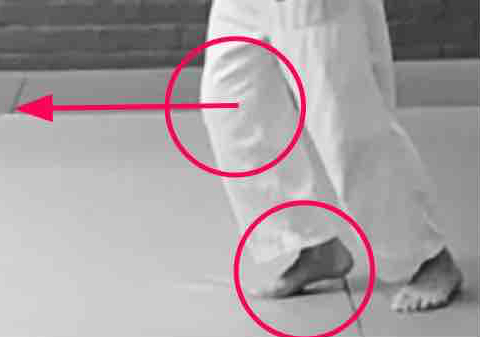Basic foot movements are a part of basic displacements. We distinguish displacement with and without foot movement. Tsugi ashi is a basic skill and is used in many martial arts in different formats. Mostly it is performed on a flat floor, for example in a dojo with a wooden floor or covered with tatami.

There are different types of tsugi ashi displacement. The most basic one is moving the front foot forward followed by a sliding back foot. When moving backward, the back foot starts first followed by the front foot.
Moving into other directions follows the same method. The foot closest to the target starts first, followed by the other foot.
In any case, the leg (foot, knee and groin) which is moving first must be flexible and no-weight bearing anymore. Gravity induces the displacement. In the article – Meditative Movements – this movement process is discussed.
We distinguish 2 tsugi ashi methods:
- Small step tsugi ashi – short distance for explosive power
- Long step tsugi ashi – big distance for long power

The small step tsugi ashi, the front foot heel is lifted and does not bearing any weight, the weight is about 30% on the ball, 70 % is on the back foot (in the middle of the foot). Using small step tsugi ashi is mainly for delivering power.

The long step tsugi ashi is a rolling foot action to cover a relative long distance.
3 kinds of distance
Chika-Ma= small step tsugi ashi
Uchi-Ma=long step tsugi ashi - musoko-ho
To-Ma=ayumi ashi or longstep tsugi ashi
Making a choice will depend on the action you are performing.
It is of course always an action of the unconscious mind and not a conscious decission. A conscious mind action is always too late when you like to outwit an opponent.
Small step tsugi ashi

A small step tsugi ashi is a displacement to adjust the distance for an explosive movement. To create “hakkei”, distance need sometimes adjusmentn, but not always.
This kind of “hakkei” or “explosive movement” can be used to create balace disturbance (kuzushi) followed by a long step tsugi ashi and/or an ayumi ashi (stepping action).
The action of the front foot has to create an opposing isometric force when the back foot is coming closer to the front foot.
Long step tsugi ashi

Long step tsugi ashi use the rolling foot skill. Mostly this skill is used after an action of “hakkei” or explosive power and continuing with a throw of controlling technique.
Rolling foot is using gravity as a source of power.
Shock absorbers and brakes
On many vehicules we have shock absorbers and brakes.
Take for example a bicycle.

The shock absorbers damp out the motions of a vehicle up and down on its springs.
A bicycle brake reduces the speed of a bicycle or prevents it from moving.
Our body has also some mechanism to absorb and to stop or slow down body movements. It also has a mechanism to prevent (unnecessary) movements.

The back leg functions as an absorber of energy and can rebound to the target.
The front leg functions as a brake to stop a forward movement, for example during a small forward step tsugi ashi. The braking system of the front leg can rebound the energy to the target.
Both stored energy can only rebound if the body is available for energy transport. Any contraction will stop the transport.
The weight on the front foot is on the ball with a slight lifting of the heel, just to put a paper under the heel.
The weight on the rear foot is more closer to the heel, but not on the heel.
The key to this kind of power manipulation is posture training. Solo or partner training.
Unsoku and tandoku undo (tegatana dosa) are good examples for this kind of solo-training
Tegatana-awase and shotei awase are examples for partner training.

5 thoughts on “Tsugi Ashi”